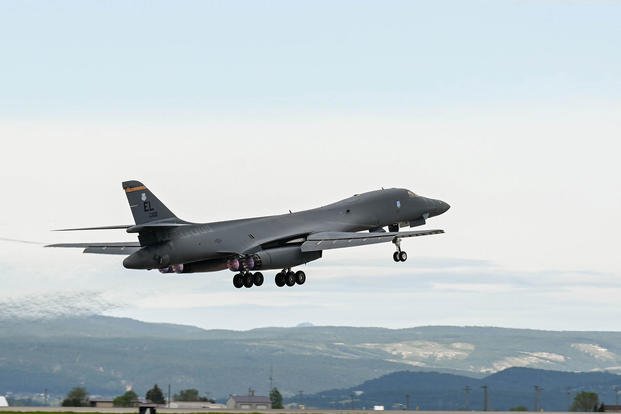
A B-1B Lancer valued at more than $450 million that crashed in South Dakota at the start of this year missed the runway by 100 feet, a mistake accident investigators attributed to the aircrew’s shortcomings as well as the poor training culture within units at Ellsworth Air Force Base.
The scathing crash investigation report shared with Military.com pointed to “failure to perform standard crew resource management,” along with adverse weather conditions, ineffective flying operations supervision, lack of awareness, and “an unhealthy organizational culture that permitted degradation of airmanship skills” as contributing factors in the Jan. 4 crash.
That incident led Ellsworth to temporarily close down its runway and relocate roughly 250 crew members and Lancers to Dyess Air Force Base near Abilene, Texas.
Read Next: Here’s Kamala Harris’ Record on Veterans and Military Issues
The B-1B Lancer, which was on a training mission, crashed roughly 100 feet shy of the runway, skidded more than 5,000 feet down the tarmac, and was then engulfed in flames from the crash. The four crew members all ejected, but two of them suffered injuries as a result. Both were medically treated and later released, according to Air Force Global Strike Command, which commissioned the crash investigation report. The Lancer was destroyed, and the damage to the aircraft and the runway was estimated to be more than $456 million.
The report also points out that one crew member who was injured during the ejection was not wearing all the proper flight equipment. And the other injured crew member’s weight was reportedly above both the ejection seat’s recommended limit of 211 pounds and the Air Force’s recommendation of 245 pounds. They weighed in at nearly 260 pounds during medical treatment, which “likely contributed to the severity of the injuries noted from the mishap.”
The B-1B was performing a training mission with another Lancer aircraft on Jan. 4 when both came in for low-visibility approaches toward the runway with low cloud cover. The first aircraft landed successfully amid dense fog, while the second Lancer came up short due to “a failure by the crew to properly manage the aircraft’s airspeed and angle of approach,” Air Force Global Strike Command detailed.
“Changes in local wind direction during landing should have prompted the crew to adjust throttles and maintain proper airspeed, but a lack of situational awareness and ineffective crew communication resulted in the aircraft falling below required airspeed to maintain a safe approach,” the command said.
Col. Erick Lord, the accident board investigation president, pointed to the crew’s shortcoming and harped on the one crew member’s weight as examples of larger cultural problems within Ellsworth Air Force Base’s 34th Bomb Squadron and the 28th Operations Support Squadron.
“The preponderance of the evidence revealed an ineffective and unhealthy culture, which directly contributed to the mishap,” he wrote. “Specifically, the [34th Bomb Squadron’s] overall lack of discipline, inadequate focus on basic airmanship skills, and failure to properly identify and mitigate risk, coupled with the [28th Operations Support Squadron’s] ineffective communication, inadequate program management, and lack of supervisory oversight, set conditions that allowed this mishap to occur by directly leading to the mishap’s cause and its three non-weather-related, substantially contributing factors.”
Retired Col. J.F. Joseph, a Marine Corps pilot who is now an aviation consultant and expert witness, told Military.com in an interview that those crew members could receive any variety of punishment or administrative actions in the wake of the report, but noted that the statements about safety culture at the base are significant.
“There appears to be some degree of supervisory error that they’re making comments on, and the basis for that is predicated on what we call safety culture,” the former aviator said. “It sounds like what they looked at was essentially a top-to-bottom review, but it really seems as though they’re focusing on the culture aspect of it.”
Air Force Global Strike Command said the chain of command is “in the process of responding to the report and taking the appropriate corrective actions.”
The last crash of a B-1B was more than a decade ago in August 2013, when a Lancer out of Ellsworth went down near Broadus, Montana, causing fire damage to private property and totaling the aircraft. Crew members aboard ejected and survived that mishap, a news release at the time detailed.
Related: B-1B Bombers and 250 Airmen Temporarily Moving from South Dakota to Texas Following Crash






